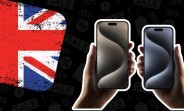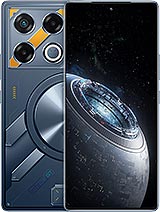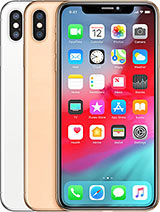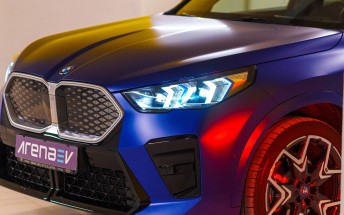Sunday Q&A - Week 12
Hello and welcome to the Week 12 edition of our Sunday Q&A! This week we discuss our battery test once again, fingerprint sensors and why we don't have more scores on the site.

Webster: Hi, I like your site for comparing phones, but would it be possible for you guys to list an IR blaster as a feature? This is one of the major points I look at when choosing a phone.
Hi, Webster. We are, in fact listing IR ports in our specs database - if you look at a phone that has it like the Xiaomi Mi 5s Plus, you’ll see a line for that. However, since it’s a rather niche feature we chose to omit the row entirely for phones that don’t have it so as to keep the length of the table under control.
Wasym: I like the fact that your reviews are very detailed but when it comes to comparing real life performance of cameras of smartphones, the compare tool is not a very good option because it requires a lot of technical know-how for any person to actually be able to spot a difference in two cameras. Is it not a very good idea that you develop a rating system for cameras, rating cameras on a scale of 1-100, like DxOmark?
Thank you for your input, Wasym, it’s much appreciated. First to address the photo and video compare tools - we don’t really think there’s a certain level of proficiency required to use the tool. You don’t need to be a pro photographer and be able to analyze all the technical aspects of every shot to take advantage of it - it’s meant to let everyone do their own comparisons.
If you don’t see any major difference between certain phones that’s perfectly fine and chances are you’ll be equally happy with their real life output as well. After all if you don’t care about a minute amount of extra noise in the test setups, chances are they won’t bother you when you get a phone and start shooting with it.
Now to move on to the oft-requested rating for cameras (or phones as a whole). The goal of this website is to help you, our readers, find the best phone for your specific use cases and budgets. Unfortunately, it’s never a one-size-fits-all kind of deal and having an auditorium of over 3 million people from all around the world each day it’s impossible to deliver a rating system that will work for everyone - heck, it’s impossible to find one that will work for even half the people.
Some want to see their photos colorful and detailed and don’t mind some extra noise. Others want a more pro-subtle post-processing as the artifacts that come with boosting color saturation and applying excessive sharpening really bother them. Some only shoot photos of buildings and landscapes when traveling so they don’t really care about the autofocus speed, but those snapping shots of their fast-moving children know it’s more important than anything else as even the best shot can be ruined if the focus is in the wrong place.
The list of priorities for a phone in general and its camera in particular is something strongly individual so each aspect of its performance carries different weight to different people. That’s why producing a final rating will only serve to start fan wars and won’t be of real help to most people - in fact it will be misleading to them. And we really rather offer an “incomplete” service than a potentially harmful one.
Satyam: Can you do a comparison between chipsets like Snapdragon, Apple and Samsung Exynos?
Doing a comparison of the Apple chips and the likes of Qualcomm and Samsung is not a good idea (or at all possible) for two reasons. First, comparing benchmarks across platforms is bound to tilt the playing field as software runs different on iOS and Android.
Secondly, even if we did manage to find a way to put together a meaningful comparison of Apple’s chipsets against their Android rivals, it wouldn’t be of use to anyone, but forum trolls. You see chipsets don’t exist in isolation - you can’t order a Galaxy smartphone with the Apple A10 chipset, nor can you get an iPhone with the latest Exynos.
So even if you did know which one is more powerful you wouldn’t be able to do anything about it. So the only thing that can be of use is comparing the new Apple chips to their predecessors so you know how much extra oomph the latest iPhone is bringing and we are already doing that.
Things are different with Android devices as there’s plenty of diversity there - both in terms of manufacturers and chipset makers. And as luck would have it, we just did a pretty detailed overview of the available options there - head this way to read it.
Abaid: I bought the Galaxy Note7 last year and we all know what happened. Now I am planning to get the Galaxy S8. I consider waiting for 3 months after the release, just to be on safe side, or going for the G6 as I heard it is using heat pipe to reduce battery temperature. Any suggestions from you guys? Did Samsung do anything with the Galaxy S8 to prevent a Note7-like issue?
First, the Note7 drama unfolded in about a month so waiting three months to see if it doesn’t repeat itself seems a bit excessive. In the aftermath of the recall Samsung explained in detail all the measures it has taken to prevent it from happening again, including 8 additional quality tests. The company’s battery division also committed to a $128M investment to boost the safety of its products - so a repeat fiasco is really unlikely.
That said, going for the LG G6 is also a viable option. Not because of its heat pipes, which are fairly common in modern flagships, or due to some inevitable Galaxy S8 implosion, but simply because it is a pretty good phone.
Ali: Hello! I am looking to buy a mid-range phone and there are some great options but, if leaks are to be believed, the snapdragon 660 and Helio X30 devices are on the horizon. Can you explain what will be the performance and efficiency difference between current crop of SoC and next generation 14nm and 10nm SoCs? Thank you!
If you are in the market for a new phone now, you probably shouldn’t be concerned about Helio X30 and the Snapdragon 660. The new MediaTek X30 chipset is unlikely to be available in any device before July at the very earliest and even if it makes that optimistic goal it will not reach the mid-range for at least another few months.
As for the S660 - it isn’t even official yet so we might not see anything with it this year. In fact we are only now getting the first Snapdragon 653 devices so it will take quite a long wait for those two.
Furthermore there are already plenty of 14nm mid-range chipsets - Snapdragon 625, Snapdragon 626 plus the Samsung Exynos 7870 and 7880. The MediaTek Helio P20 and P25 are built on 16nm and so are the Huawei Kirin 650, 655 and 658.
Minimization of the production process allows for proportionally higher power-efficiency as the elements are smaller and require less power to operate. Mind you, the better power-efficiency doesn’t necessary yield better battery life - the manufacturer can instead choose to up the clock speed and transfer some or all of the gains to a higher clock speed, while maintaining the original power consumption.
The thing is the jump from 14nm to 10nm isn’t nearly as big as the one from 28nm to 14nm so we aren’t looking at another huge jump, but merely a nice evolution step. So evaluating the potential reward versus the waiting required it’s probably not worth it and you might go for whatever is available right now.
Jaison007: Which is the best location for the fingerprint sensor on a phone? In the front or at the back? Where does GSMArena prefer it to be?
Hi Jaison, there are actually not two, but three different positions for the fingerprint sensor - Sony likes to put it on the side of its phones. And each of the locations has its pros and cons that we’ll try and sum up here.
A fingerprint on the front means you can unlock the phone when it laying beside you on a table without picking it up. It’s also easier to reach for some people depending on the size of the phone and the specific manner in which you hold it.
Placing the fingerprint on the back means it’s easier to hit when you take the phone out of your pocket - it normally falls just under your index finger. Removing it from the front also lets manufacturers remove the home button and trim the bottom bezel. Finally fingerprint swipe gestures (those are still relatively rare) are easier to perform.
The obvious downside on the rear-mounted sensor is that you can’t use it when the phone is laying on a table or a desk. It can also contribute to thickness or make the design of the back a little too busy if the camera setup is more complex than usual (LG G5 says hi).
The fingerprint on the side is always easy to reach and always there no matter if the phone is in your pocket or laying beside you. However performing any gestures with it is bound to be super awkward and it could explain why Sony isn’t doing those. More important downside is that the side placement means you need to have some extra bezel next to your screen for the module to fit. This doesn’t really go great with the current consumer demands for larger screens in bodies as narrow as possible so they are still manageable.
Finally, an exciting new development could see the fingerprint sensor being placed underneath the display itself, which should take care of a few of the issues listed above at the same time. Rumor even had it that Samsung wanted to go that way with the Galaxy S8, but the technology wasn’t ready in time and the company had to make a last minute change and go with a rear-mounted sensor (that should also explain its off-center positioning.
To answer your other question - there’s no clear favorite position among our team. Yours truly would go with a rear-mounted sensor anytime, but many of my colleagues swear by the frontal location. The Sony side position also has a few fans, so it’s a pretty even split.
Anonymous: Can you please explain the differences between screen types used in smartphones? Many users always ask about it and we do not have a clear understanding of TN, TFT, IPS, LCD, LED, OLED, AMOLED & Super AMOLED. There are also confusing combination like IPS LCD, IPS-Neo, TFT LCD and so on. Sometimes I thought it is a typo on your behalf when reading the phone specs though I might be the ignorant one here.
There’s plenty written on the web on the differences between the different screen types, but by asking this question I assume you want a quick and simple explanation rather than a bunch of technical terms.
There are two main types of screens - LCD and OLED (AMOLED is an OLED sub-type and all OLED smartphones use AMOLD panels). LCD is the older technology and it relies on a backlight that gets filtered through a layer of colored crystals to produce different colors. To display black it just makes that layer as non-transparent as possible, but it can’t completely switch off the backlight as it will just shut off the entire display.
With OLEDs on the other hand, each individual pixel lights up so when it needs to display black, the pixel just switches off.
As for those other listed abbreviations - all smartphone LCDs are TFT, but spelling it out every time is a bit redundant so you don’t see TFT LCD every time. TN and IPS are two different types of arrangements for the crystal arrangements with IPS being a newer technology and allowing for improved contrast and wider viewing angles. The LED is another type of LCD, where the backlight is not a single bulb but a bunch of small diodes.
IPS-Neo on the other hand is merely a brand for a specific IPS LCD implementation. This means that the Neo doesn’t identify a specific technology, but is merely a catchy name a maker has decided to use. It’s much the same way with Super AMOLED - it’s the brand Samsung uses for its recent panels, but it doesn’t mean anything by itself.
At the end of the day specific implementation of different display types vary quite a bit so the only way to be sure what works for you is to either get the phone and see for yourself or check out the display section of our reviews.
Jim H: What was the effect of standardizing of brightness for battery life tests? Did the numbers tend to decrease for the majority of phones tested? Which brands or phones were benefiting the most from a lower brightness at the previous test's percentage?
For the majority of phones the effect was minimal - a large percentage of those were close to 200 nits at their respective 50% settings, so it didn’t really make much difference. And no there wasn’t a decrease across the board - we’ve only done the test both ways on a few handsets and some did slightly better, some slightly worse. None saw a dramatic change though.
What it helped though is in seeding out the outliers - the ones who had their brightness south of 100nits and the ones that had over 300 nits at 50%. We hope that this move has made their battery test results more comparable to the other tested devices.
Some of the outliers in question include pre-Android Blackberries, which usually had significantly higher brightness level than 200nits - upwards of 300 nits. Most Huawei and Meizu phones had brightness bellow 150nits - often closer to 100nits and those might have scored differently under the old testing procedures.
Nokia Lumia phones were all over the place - some significantly lower than 200 nits, while other were much higher.Samsung's tablets had an average brightness of around 300nits.
But you have got to remember that we transitioned to the 200nit battery tests more than a full year ago (January 2016 to be precise), so the models tested the old way are already at the end of their life or on their way towards that.
If you have any questions for us - you can send them by using the form over here.
Related
Reader comments
- Screens Maniac
- 28 Mar 2017
- pEP
Also whats can improve screen quality to eliminating brightening screen up at direct sun and save a lot battery, to have better true black and other colors at direct sun, also having better screen viewing angles because nowdays sun polarization layer...
- Screens Maniac
- 27 Mar 2017
- pEP
I think easier is spell and explain screen technology by screen technology name alphabet: LED: Light - emitting diode. For LED-backlighted displays. LED-backlit LCD is a flat panel display which uses LED backlighting instead of the cold cathode fl...
- Boldy
- 26 Mar 2017
- 9xn
LED display refers to LED backlit LCD displays. They still use the crystal filteration. However, by using multiple LEDs as backlight, you avoid brightness degradation at corners compared to centre. It looks more even as a result. Most LCD panel...





 Samsung
Samsung Infinix
Infinix Apple
Apple Apple
Apple Xiaomi
Xiaomi


